

Ignoring customer complaints can be a costly mistake for any business.
Over 90% of dissatisfied customers will silently leave without any feedback, taking their grievances to social media instead. Regardless of your industry, complaints are inevitable and must be dealt with.

It’s just as vital to prioritize customer satisfaction if the customer is at fault or misinformed. That’s why we’ve gathered insights from industry experts to help you tackle common customer complaints and maintain a positive reputation.
Customer complaints should not be considered mere inconveniences because they can significantly impact a company’s reputation if mishandled.
Customer complaints offer valuable feedback on a business’s product or service, highlighting key areas of improvement. By actively listening to complaints, companies can enhance their understanding of their customer’s experience and improve their satisfaction.
Addressing these complaints can also help build trust and loyalty with customers, demonstrating that their concerns are taken seriously and that the business is committed to providing a high level of service.
Call center agents are often trained to handle customer complaints in a call center, as it’s essential to maintain customer satisfaction and loyalty and increase customer retention.
Happy customers are likelier to stick around, recommend the business to others, and leave glowing reviews. This builds a positive reputation and drives revenue growth.
Addressing complaints also helps businesses identify and correct product or service issues, resulting in fewer complaints over time and an overall improvement in the quality of products and services.
Ignoring customer complaints can lead to dissatisfied customers, resulting in lost revenue and a damaged reputation. Negative feedback can spread like wildfire on social media and review sites, deterring potential customers from doing business with the company.
In addition, unresolved complaints can indicate deeper issues with a business’s products or services that must be addressed. Failing to address these issues can lead to more customer complaints, reduced sales, and even legal action.
Addressing customer complaints can increase customer retention and loyalty and decrease churn. By addressing the customer’s concerns and providing a timely and satisfactory resolution, businesses can demonstrate their commitment to customer service.
This can lead to increased customer loyalty and retention. Satisfied customers will remain loyal to the business and recommend it to others.
Before explaining the complaints, let’s quickly remember what makes a customer complain. There could be different types of customer complaints. It could be related to common unhappy instances like
a) improper or lost communication,
b) internal processes or
c) poor quality of service or
d) when a product goes out of stock,
Complaints should not be taken negatively. A complaint is an opportunity. And with an effective service, you can turn conflict into positive change.
So, let’s get solving the complaints with the help of experts!
This section looks at common customer complaints and how to handle them.
My order arrived after the original delivery date
BretBonnet, Quality Logo Products, Inc. says that 9 times out of 10, the courier is to blame. But pointing fingers never helps to move the situation forward.
In this situation, the best thing you can do is write it off as the price of doing business and then do everything you can to make the customer happy. If that means they get an extra order from the deal, so be it.
You want the customer to be willing to work with you again and to recommend your services to others.

StacyMatyl, Marketing Specialist at ScienceSoft, gives an instance of a customer complaint. A customer blames a product for failing to fulfill their needs when it turns out they just don’t know how to use it properly.
The remedy to the above situation is to find out the customer’s goals and needs and then educate them on how to use the product to get what they need.
Another helpful technique is to reassess your product use guidelines and adjust them based on customer feedback. You can offer a personalized product demonstration, user manual, and YouTube video tutorial with a follow-up call.
As a result, the customer will likely be pleased and recommend the product to others.

Your email does not help. Can you help me. Please?
According to William Schumacher, Founder & CEO of Uprising Food, some websites only would provide a customer service email, and that email would be generally unresponsive. When we created our e-commerce website, we wanted to resolve that issue by incorporating a live chat directly on our site.
Live chat is great because it gives consumers accessibility straight from your website without having to abandon to seek support elsewhere. Comfort and ease are what help create good relationships with your clients.
The nature of assistance and the speed at which it is provided are the two most cited reasons consumers feel they have had a pleasant company experience.
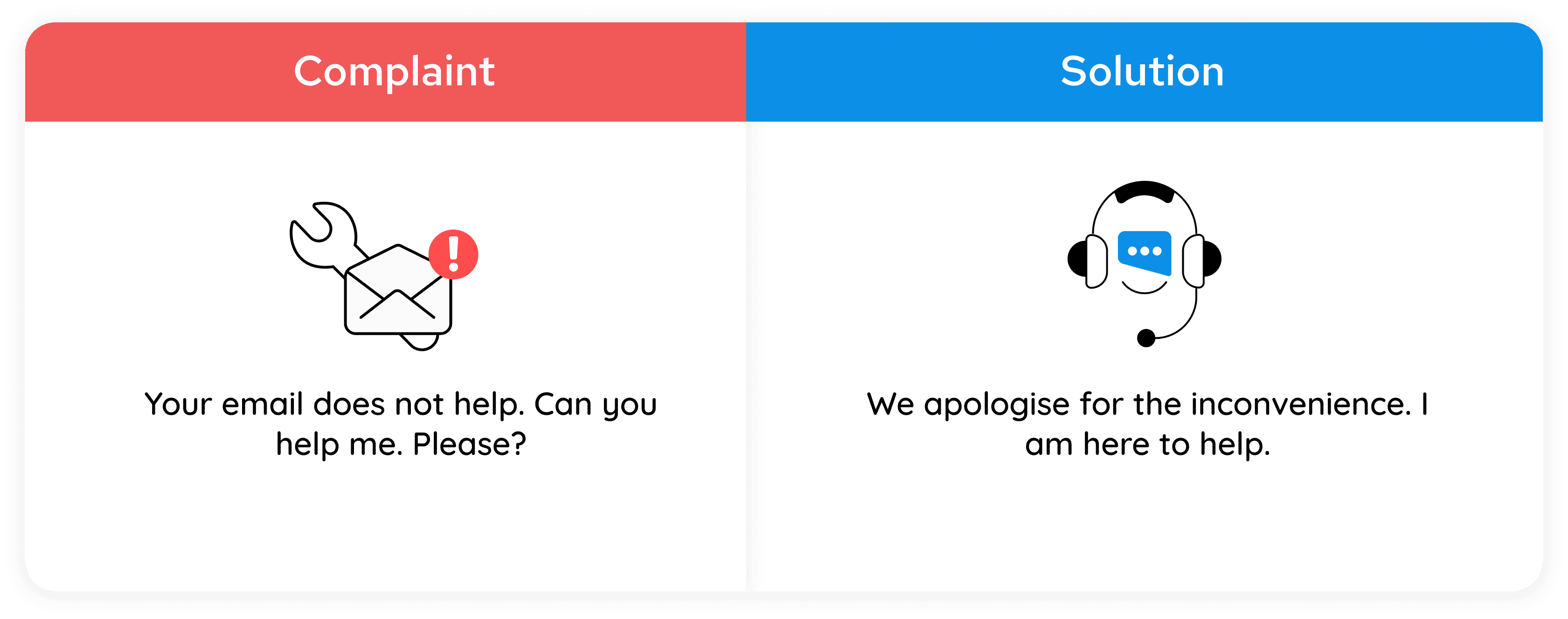
Please solve my issue, I am calling for the third time!
Lack of a first-call resolution happens when a customer has to call your service team more than once before resolving their issue.
JustCall offers high-quality support because our service reps begin customer interactions by noting each case’s urgency. Our reps find ways to resolve the case within the first call. They prefer not to waste much time researching or repeating steps.
If the agent finds no answer to the query, they politely ask for a quick follow-up. Sometimes customers become impatient. It is important, then, to explain to them how the process will yield faster solutions.
Moreover, if a customer had to call multiple times to solve their problem, it could be the case that their calls went to the wrong department.
JustCall’s Interactive Voice Response system can significantly reduce the time taken to resolve customer queries by providing an interactive menu to customers. Customers can easily navigate the menu and select the department that best suits their needs. This eliminates the need for customers to wait on hold or be transferred to various departments, which can be time-consuming and frustrating.
We also have self-service support options on the JustCall website, a wide knowledge base for customers to help them find solutions themselves. That creates a more convenient and enjoyable customer service experience.

AnatoliiUlitovskyi, SEOtools.TV believes that most customers are impatient and demand an immediate response. If your business can’t reply now, be ready for your competitors to provide this service instead.
We live in a world with many automatization options: chatbots, FAQs, auto-replies, video tutorials, step-by-step guides, etc.
It’s essential to learn how your customers want to get support.
For instance, my team found out that most customers ask the same questions, so we made videos to answer them. When we get those questions, we send the videos to help them quickly. We also use chatbots and LinkedIn to reply as fast as we can.
It’s been 2 months since your product is out of stock!
James Idayi, CEO of Cloudzat, says that when an item goes out of order, it’s usually a positive sign. However, if the product remains out of stock for an extended period, they can request a particular order or regular product updates.
Managers should report the complaint to the sales and stock management departments to handle this issue. Customers should be encouraged to be patient, and service representatives should inform them that they will contact them after the goods arrive.
Suppose the customer is complaining about the product being out of stock for too long. In that case, you can also offer a pre-order option with an estimated delivery date and an email notification service for restocking. You could offer a discount code for the customer’s next purchase as a gesture of goodwill.

Your product is faulty. I want a replacement!
Mikkel Andreassen, Customer Experience Manager at Dixa, shares her experience. One of the most common claims comes when the product is broken or damaged. It can also happen that the product is in good condition, but the person does not know how to use it. In this situation, your main task is not to let the customer go to the competition.
(a) If the product is working, guide the customer on how to use it. Find out the reason for the purchase and show how to use your product for that need.
(b) If the product is broken or the service does not work, inform the customer about the process for the change.
Show that you care about customer satisfaction and take care of the company’s image.
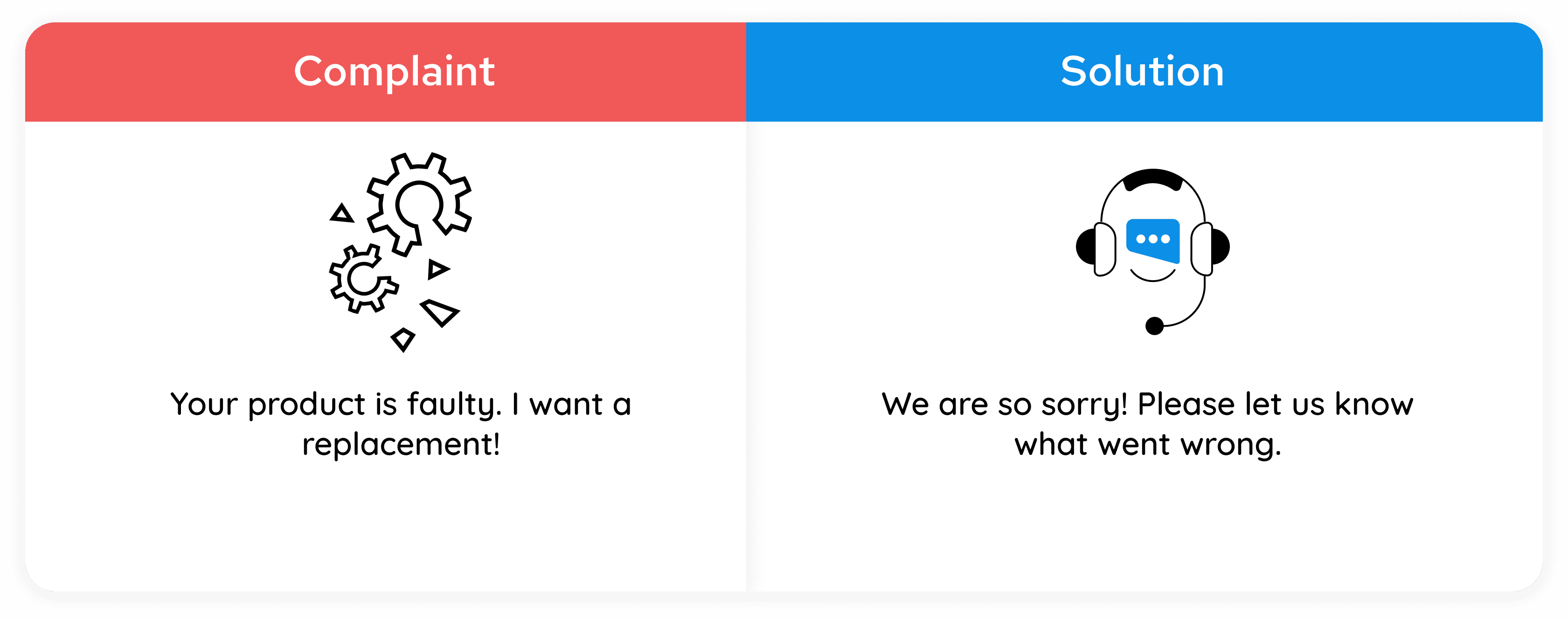
The service was excellent but the pricing is a little high!”
Michael Alexis, CEO of TeamBuilding, agrees this feedback can seem difficult to navigate as the customer is otherwise happy, but the value proposition is off somehow. As a customer service officer, you may not be able to modify pricing, so it can seem like you have limited options to provide five-star service.
First, thank the customer with a detailed message like, “I appreciate you saying that because it gives us insight on XYZ.” Many customers, including this type, want to know they are being heard.
Then, offer what solutions you can. For example, you might give the customer credit to try the service again in the future. If you follow this two-step process, you will likely create a successful resolution for this customer type.
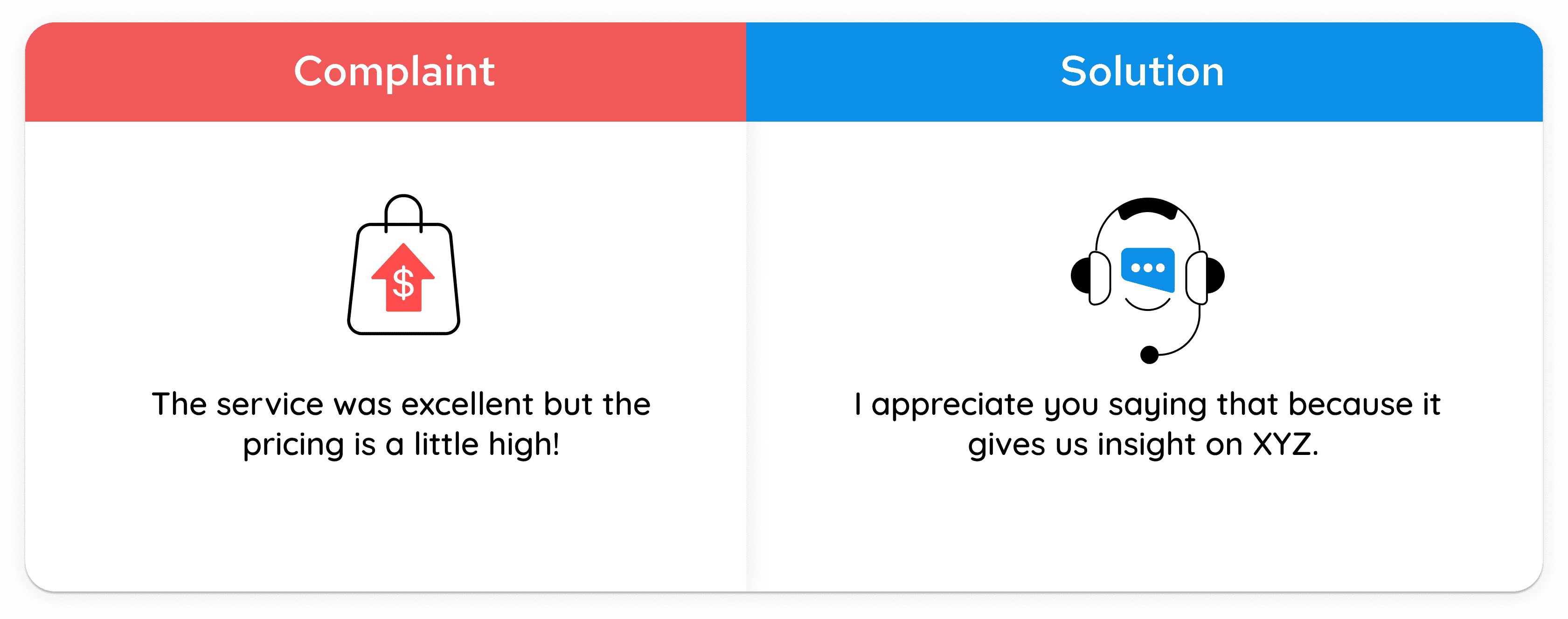
Daivat Dholakia, Director of Operations at Force by Mojio, explains that by saying the above, customers usually mean that your automated system did not fix their problem.
It’s important to acknowledge that to the customer, listen to them, and take notes on their concerns. Make sure to keep the systems updated and keep the menu options ordered by frequency of the customer concern. Ideally, you want most customers to hear a menu option that applies to them within 20 seconds of dialing in.
If you’re getting a lot of complaints about your automated system, it may be time for a review. Even small changes (i.e., changing Press 2 for billing concerns to Press 2 for billing, payment, and balance information) can help clear up confusion
and negate potential complaints.

I had no follow-up from your team!
I had no updates of my product!
Linktracker Pro’s founder Israel Gaudette suggests never letting your customers feel ignored or forgotten. Once they get a delayed response or, worse, you fail to get back to them, they’ll surely get angrier.
To counter this, it’s best to be upfront with them. Make clear expectations. If they agree to a follow-up, tell them what and when to expect that follow-up. With it, they’ll be more than willing to wait and will lower their chances of getting irritated and raising a complaint.
Once you’ve set the follow-up arrangements with the customer, get back to them promptly. If you promised to follow up with them on a specific date and time, commit to it. Once you provide them with constant updates, you’ll be surprised to see them being patient, even if resolutions take longer than expected.
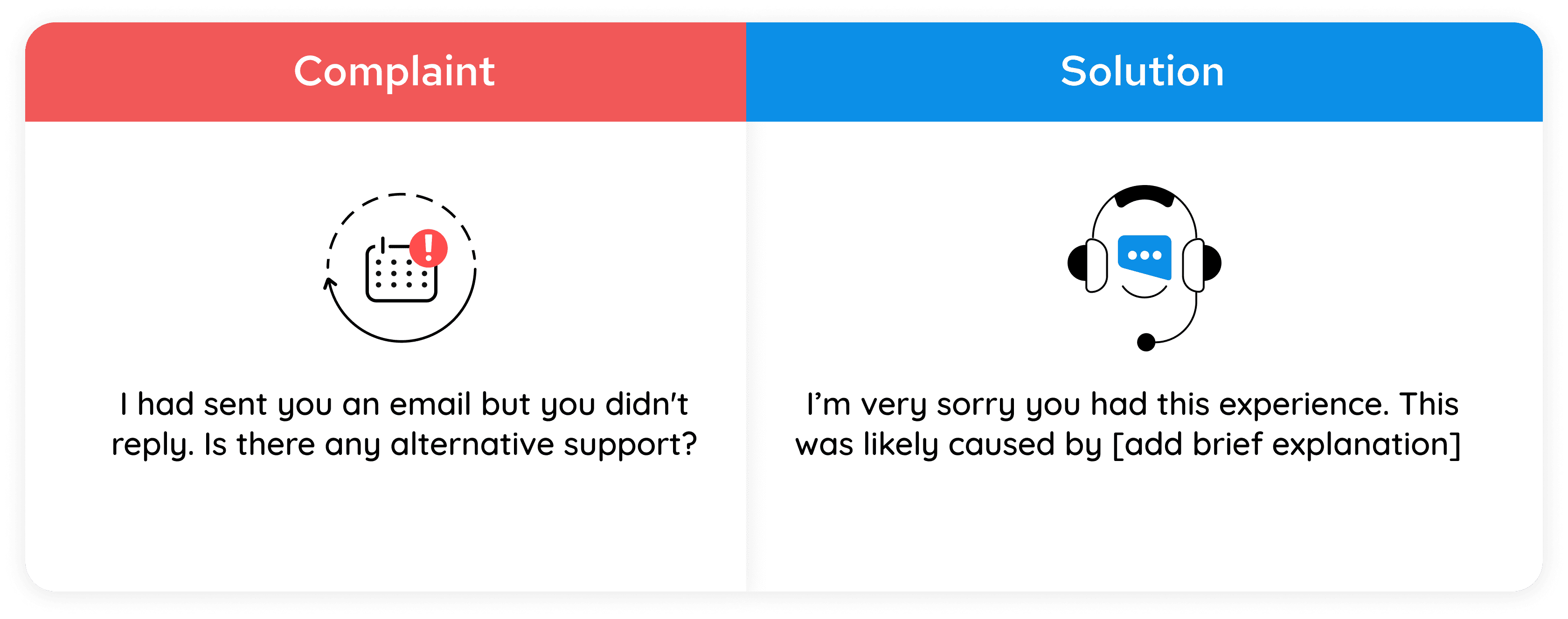
I have been charged twice for the same transaction!
Zach Reece, Owner & COO at Colony Roofers, gives an easy example. The customer was charged twice for the same service, and now (s)he incurred an overdraft fee from the bank.
Call the bank immediately and explain the situation to them. Ask them to charge the overdraft fee to your company account and cancel both charges you placed on the customer.
Then tell the customer that the service you originally performed is free of charge to them and that you paid for the overdraft fee. Don’t forget to apologize profusely for the inconvenience and tell them that you understand how serious it can be to overdraft on your checking account (due to its impact on your credit score).

I keep getting transferred from one person to the another!
MarkCondon, Owner & CEO at Shotkit, shares his experience of the past five years. One common complaint we often get is about repeating the complaint over and again when the calls are transferred to a senior executive.
To resolve this, we ensure that we transfer calls only when it is extremely important. Even in doing that, the executive must first intimate the problem to the senior executive before he speaks to the customer. We are also working towards installing help desk software that assigns the query to the most suitable agent.
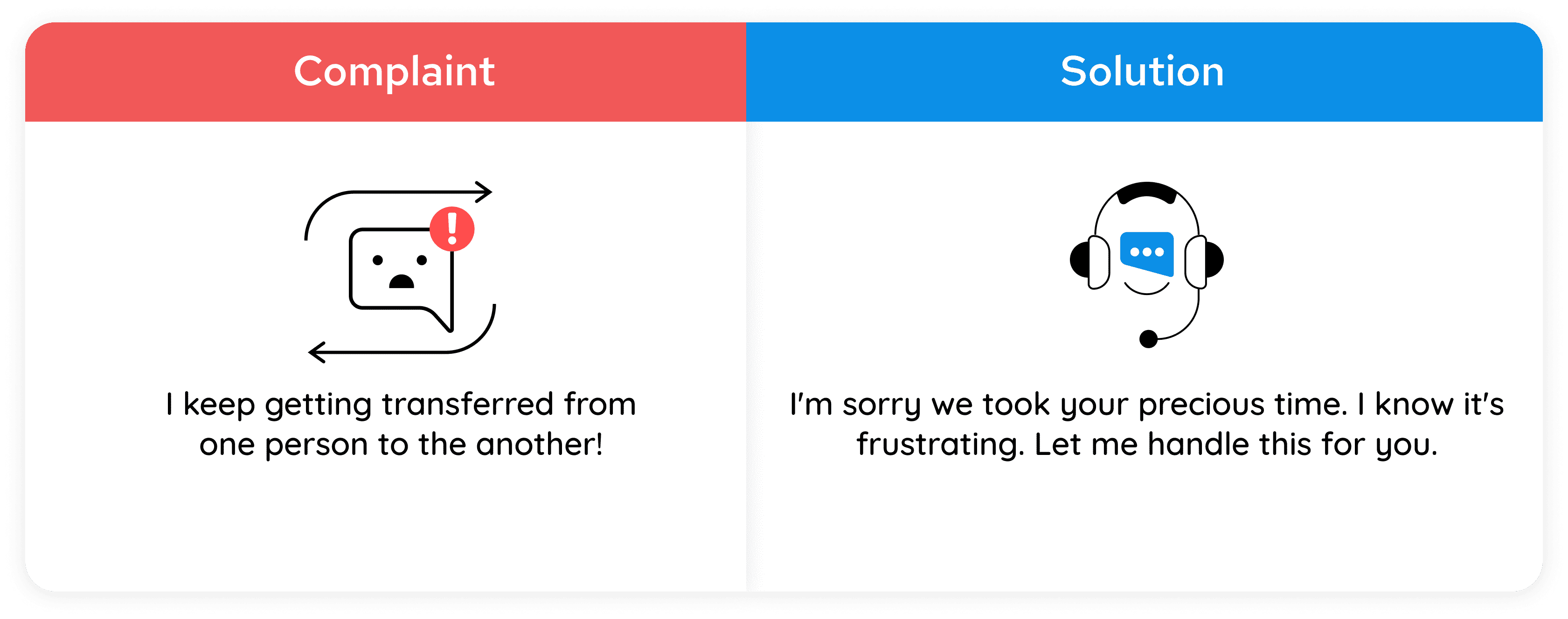
Was on hold for 10 minutes and the rep hung on me!
Rex Freiberger, the Co-CEO at GadgetReview, says that one of the things customers complain about most is wait time. This is even worse when they’re trying to get help for something else and encounter a lengthy wait to be assisted. They’re already in a less-than-charitable mood, and the delay in resolving their issue makes it much worse.
A good customer service agent will apologize for the wait and sound understanding but not condescending. They’ll endeavor to give efficient service that cuts through the usual runaround of a script and addresses the customer’s main problem as quickly as possible.
Automation can help businesses with this as it drastically shortens wait times by giving CS agents what they need to do their jobs as efficiently as possible.

James Hudson, V7 Labs, says that One of the most common (and difficult) customer complaints to handle is related to missed deadlines – whether it’s about the feature that was supposed to be delivered sooner or a project that you’re helping them complete.
Obviously, the best way out is to stick to the customer success mantra of under-promising and over-delivering. Explaining to a customer the actual reasons for the delay and being proactive in reaching out to them is the only strategy that can work.
It shows your respect for them and their time and allows you to build a better relationship based on trust and mutual understanding. A simple apology can go a long way. And if that doesn’t suffice, consider throwing in a small compensation to help them forgive you faster.
If a customer says – “I was promised my order would be delivered by Friday, but it didn’t arrive until Monday. This caused me a lot of inconveniences and lost time.” A good way for the business to respond would be to acknowledge the mistake, apologize, and offer compensation for the inconvenience caused.
Luiza Strach, Head of Customer Support at Surfer, shares her opinion. She says that the most common requests are these:
In most cases, we do satisfy these demands. We don’t want our clients’ money out of pity. We figured it’s better to give the money back, even if it’s “against the rules,” than to find bad reviews online later.
So: If someone asks for cancellation, do it. Chances are, they’ll come back to you one day – and they definitely won’t if you trap them and refuse to cooperate!
On the other hand, for manufacturing businesses – customers may seek a refund after the cancellation period has passed. They may not have been able to use the product due to a manufacturing defect that was only discovered recently.
In such a case, since the product defect was not discovered until after the standard cancellation period had passed, consider providing a full refund for the product.
By handling the complaint professionally and empathetically, you can turn a negative experience into a positive one for the customer and retain their business in the future.
Want to impress your customers with expert solutions to every tricky situation?? Get on a call with our service experts, now!

When handling customer complaints, there are several key factors to consider. Here are some essential points to keep in mind:
At JustCall, building healthy customer relationships is of utmost priority. So, here we share with you the ATSURe model of handling customer complaints efficiently.
The model comprises 5 essential steps.
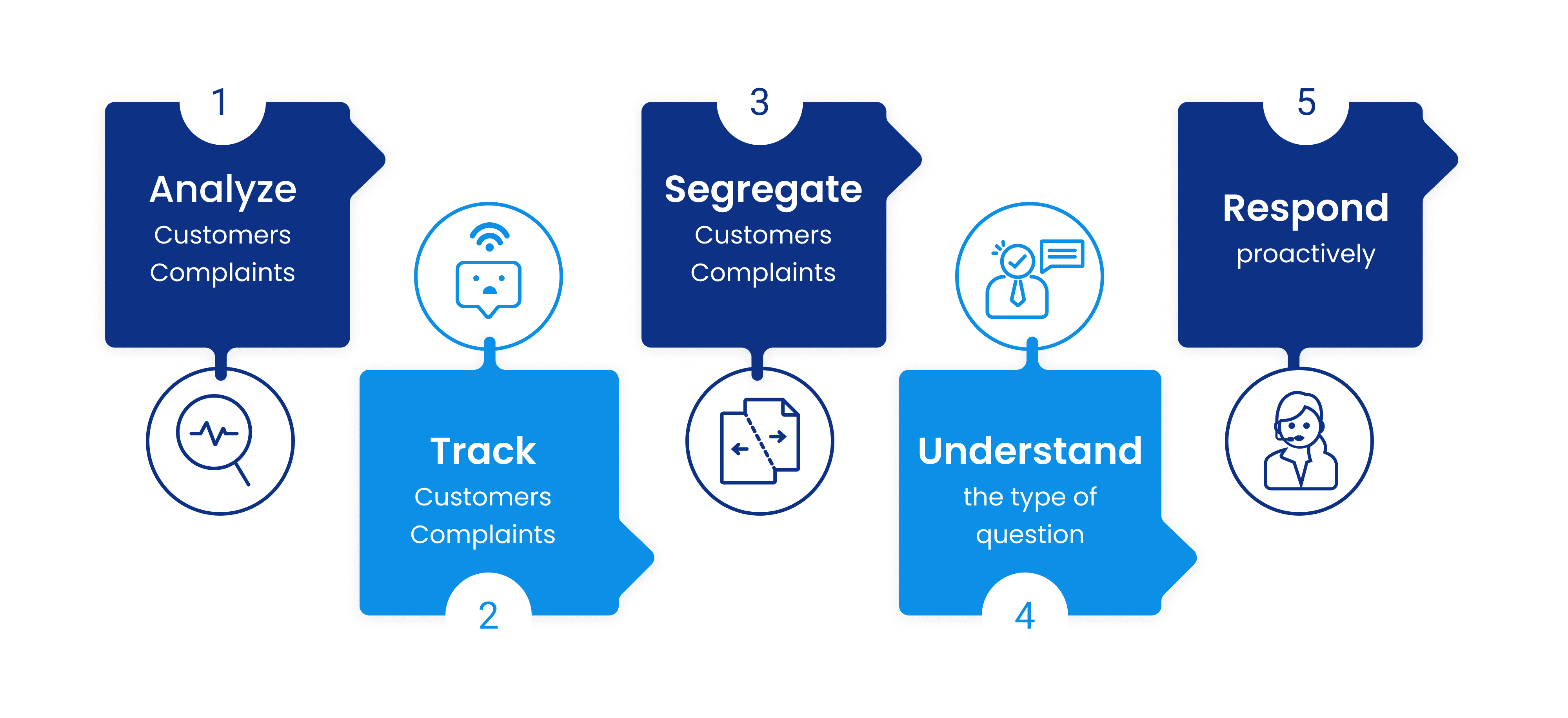
Try to know and understand the root cause of the customer complaint. Customers complain because your service or product has not matched their expectations. It can be due to a lack of information, slow response time, or late or no delivery.
It can be any of the reasons mentioned above. Or it may also be due to a condition other than the above.
Which customer complaint is one of the most common and not mentioned above? You can discuss this with our customer service experts today!
Tracking customer complaints is the process of capturing all negative feedback regarding your organization’s services or products. You need to track complaints so that you do not give your customer a second chance to complain.
Complaint Management Software allows organizations to record, resolve, and respond to customer complaints and requests, facilitating feedback. It helps handle multiple problems with simple solutions, giving you ample time to concentrate on other important tasks.
Segregate the complaint types based on reason so that the right department gets assisted with complaint management. In this way, the complaint gets solved with expertise and ease.
When a group of customers is sent personalized messages as part of a marketing mix designed around their needs, it’s easier for companies to send those customers special offers to encourage them to buy more products.
Every query is different. Hence, you need to understand what type it is. Your attitude, response, and action will be based on your understanding of the question.
If the client puts up a queue of questions, you need patience. If the client wants a refund or a cancellation, you must put up an offer or a free coupon.
Petra Odak, CMO at Better Proposals, thinks that when a customer complains to us, it’s usually because they haven’t read our FAQs and product guide and rushed through things.
It’s not that something cannot be done; it’s just that they didn’t read the instructions. When this happens, it’s important to respond as quickly as possible.
We cut down our first response time to less than 15 minutes, which greatly improved our customer success metrics and ensured that fewer customers left us. Speed is everything in an age where a customer can sign up with a competitor in less than a few minutes.
When customers have complaints or concerns, addressing their issues with empathy and respect can go a long way in resolving the situation. Here are a few scripts for the most common customer complaints:
Late Delivery customer complaint: My order hasn’t arrived yet, and it’s already past the promised delivery date.
Script: We apologize for the inconvenience caused by the late delivery. We understand how frustrating it can be to wait longer than expected. Let us check on the status of your order and expedite it for you.
Product Defect customer complaint: I received a defective product. It’s not working as it should.
Script: We apologize for the inconvenience caused by the defective product. We take product quality seriously and want to make this right for you. Let us send a replacement product or issue a refund for you.
Poor Communication customer complaint: Your customer service never answers the phone, and I never receive a response to my emails.
Script: We apologize for the poor communication experience. We value your time and want to ensure we are available to address any concerns or questions. Let us investigate the issue and ensure you receive timely and effective communication from us.
Billing Issue customer complaint: My bill is incorrect. I’ve been overcharged, and I’m not sure why.
Script: We apologize for the billing error. We take billing accuracy seriously and want to resolve the issue for you. Let us investigate the error and issue a refund for any overcharges or adjust the bill accordingly.
Unfulfilled Expectations customer complaint: The product I received doesn’t meet my expectations.
Script: We apologize that the product did not meet your expectations. We want to make sure that you are satisfied with your purchase. Let us work with you to find a solution, whether it’s a replacement product or a refund.
To simplify the complaints handling procedure, here are some best practices you can follow –
Ashwin Sokke, the co-founder of WOW Skin Science, is of the opinion that you should make it easy for customers to get in touch with you with different Toll-Free Numbers in different parts of your funnel and emails.
Also, assign dedicated customer support agents for specific departments that handle various customer service aspects.
Enable SMS customer support to enhance how customers contact your customer support teams. By setting up these systems, you will be able to solve each customer’s issue much faster, saving them time and improving satisfaction
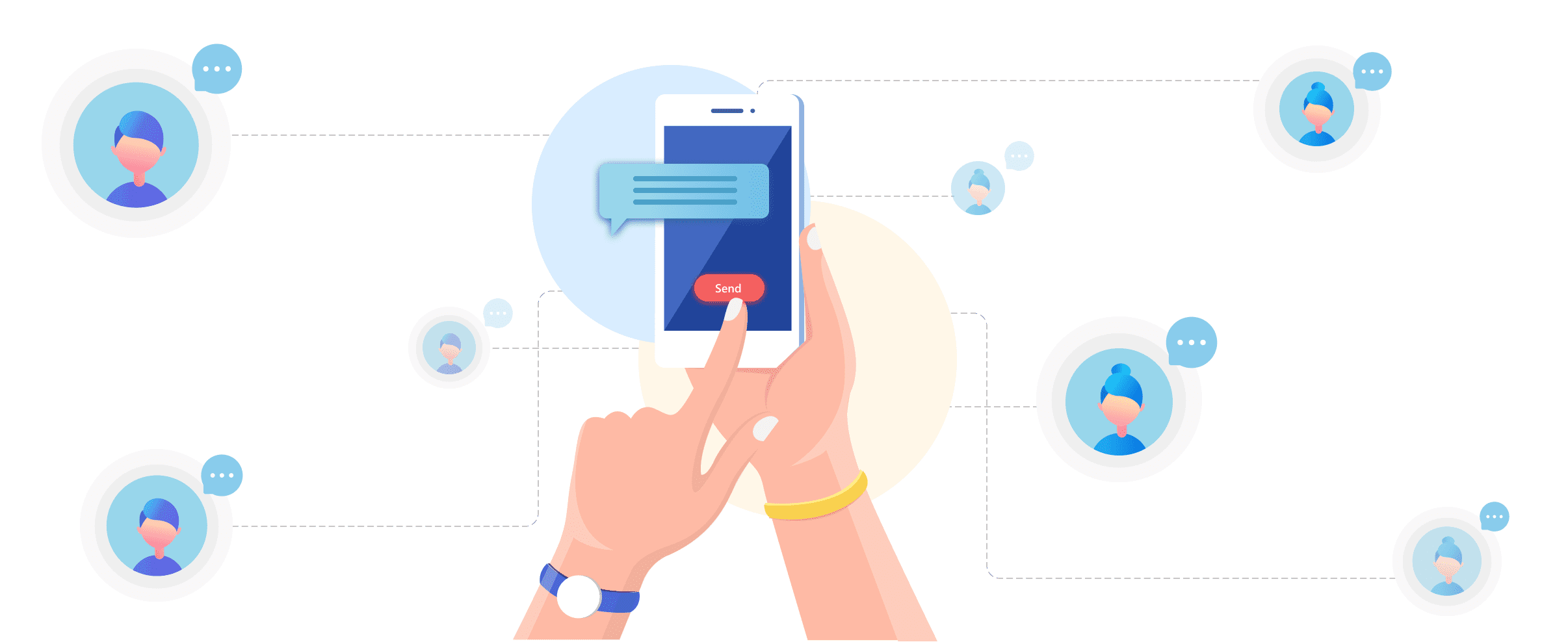
Brandon Monaghan, co-founder of Miracle Brand shares what he and his team follow. When it comes to dealing with angry customers, it is all about listening. Understand the customer’s frustrations. Show care for the problem, focus on being a good listener, repeat what the customer is explaining, and pause to process the information.
You have to make it your problem and take ownership of the customer’s question. Allow them to get it out, they will need to vent, and it starts with you. Avoid any assumptions.
Lastly, be respectful throughout the entire process. The resolution might require patience and time but in the end, the customer will appreciate your efforts.
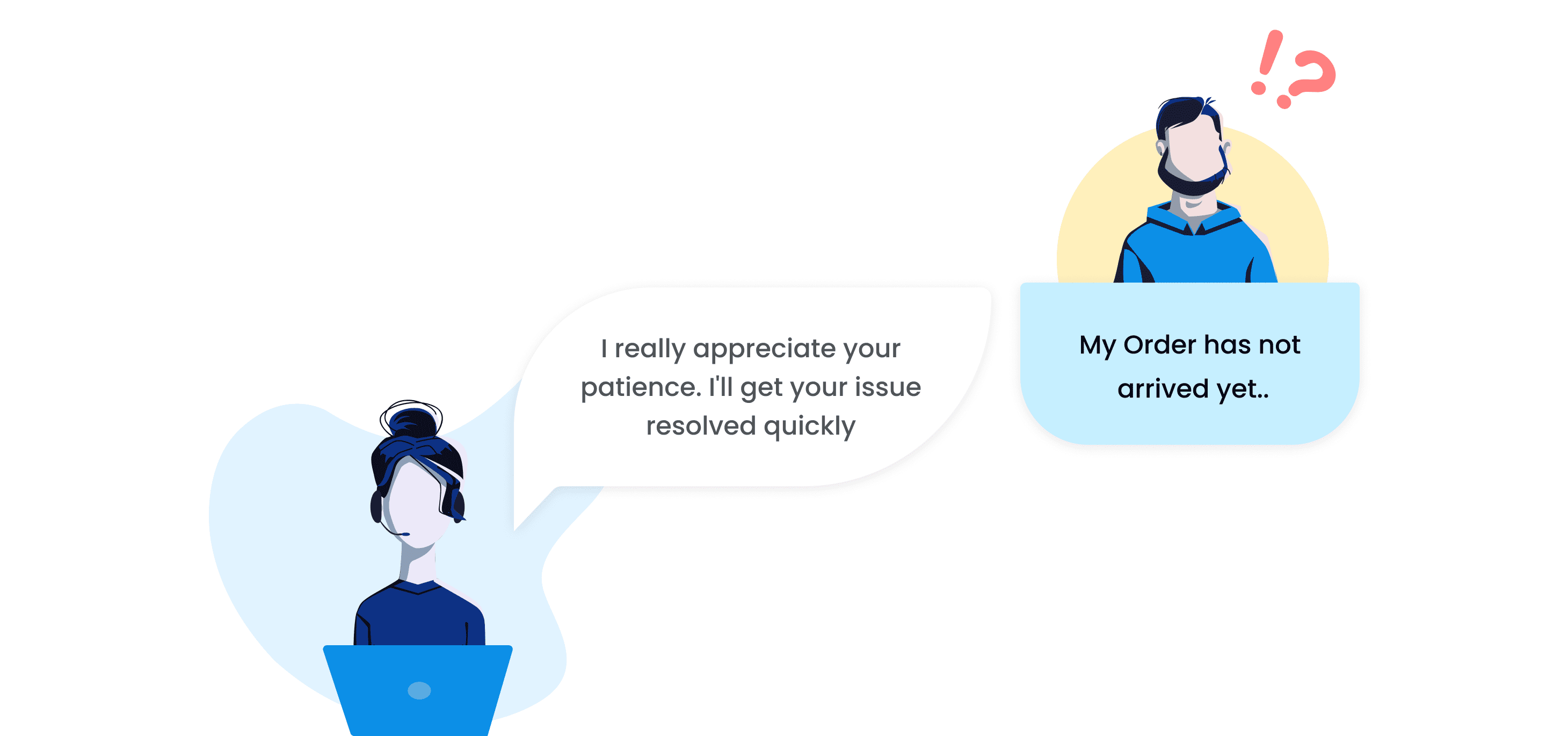
According to Eric Kim, co-owner & Program Director of LA Tutors, there will always be a client who is dissatisfied with their results and asks for accommodations or a refund against company policy.
Sometimes, the only way to win the customer over is to apologize, show deep empathy, meet them where they are, and walk through their options with them.
The most critical component of customer service is listening to them and showing them you understand.
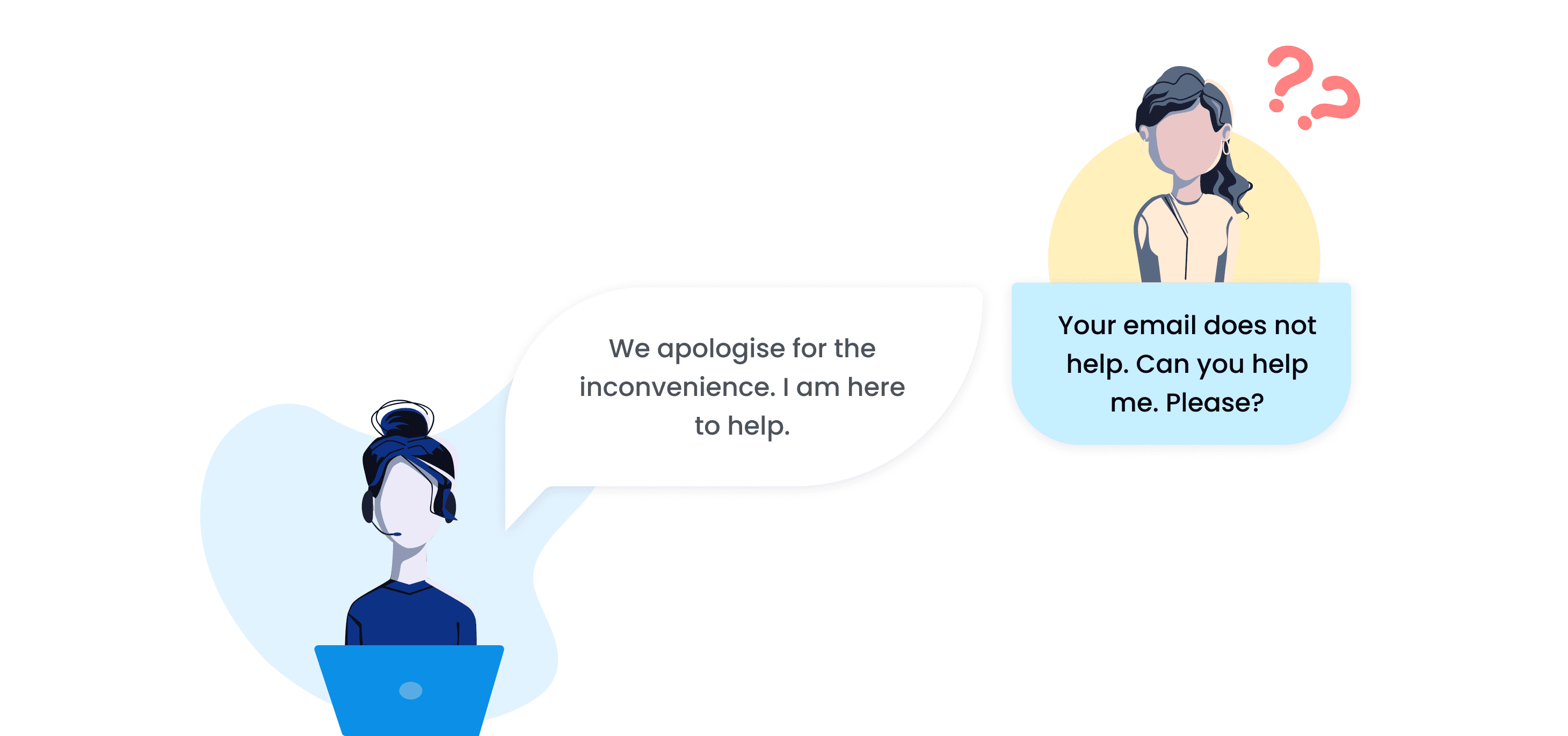
Not handling customer complaints with care means losing them to your competitors. Whether during the onboarding or closing a deal, stepping into the customer’s shoes is the first step to being empathetic.
Good customer experiences are built with EMPATHY. Having a handy list of empathy statements from industry experts saves you more deals and wins more customers.
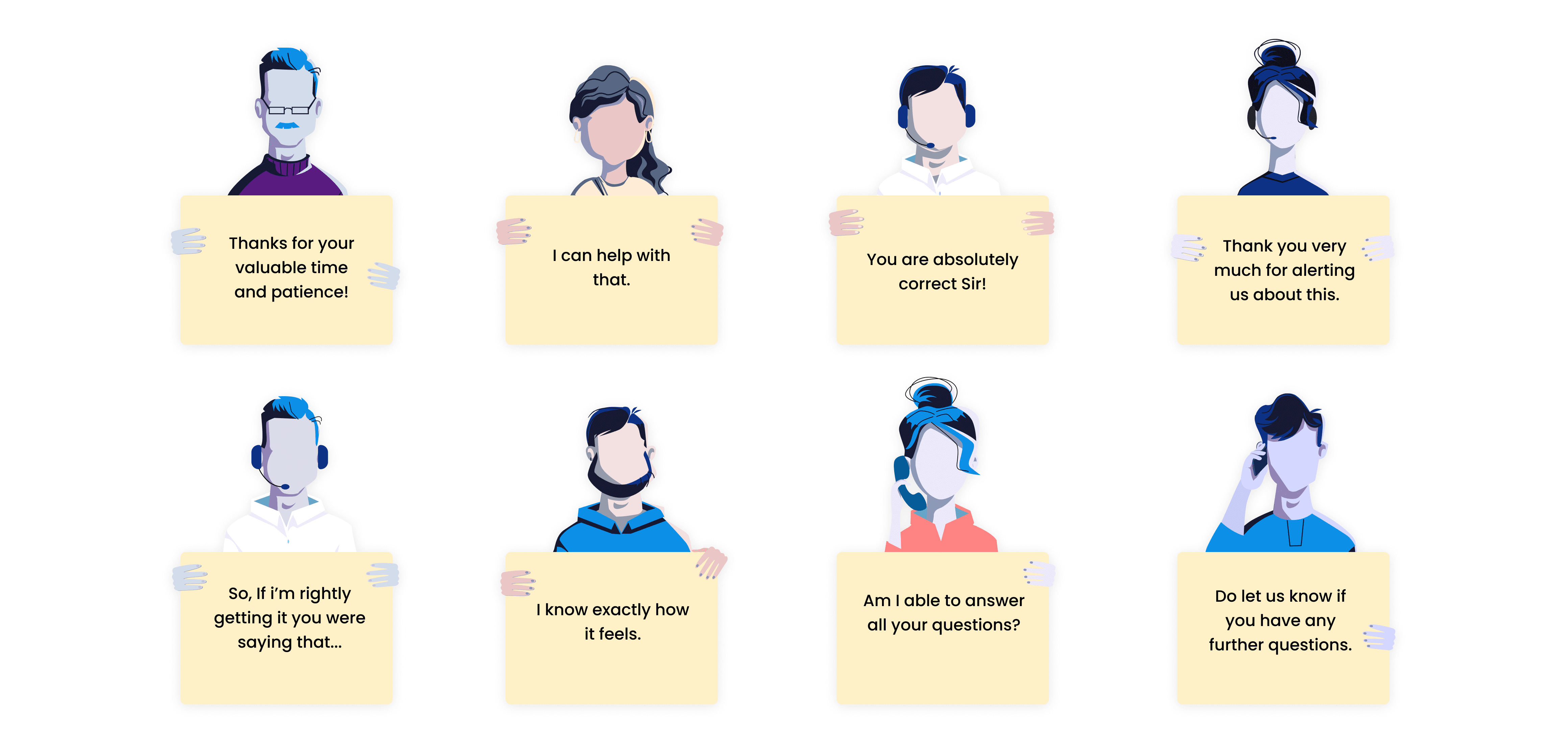
Daniel Foley, CMO at Scooter Guide, prefers routined follow-up. Reaching your angry customer after discovering a solution for them might be the last thing you want to do, but after all that hard work, following up with your customer is the icing on the cake for them.
It lets them know that their concerns are top of mind and that you care. During this follow-up, apologize again and ensure you’ve covered everything they needed.
At this point, if the customer is happy, there’s a good chance that they will return to you for your services and tell their friends and family about you and how good your customer service is.
Customer complaints are not just negative feedback. They’re growth opportunities. By fine-tuning workflows and strategies, businesses can turn complaints into positive experiences.
Get equipped with our guide to handling complaints. Our experts are always available to help you handle customer complaints in a way that works for your business.